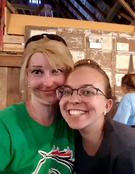
Following a hot, humid summer - which led to fantastically dry trails! - we were more than ready to head off to our first Endurance ride of the season. We only attend those within a couple of hours of home, but last year had missed the inaugural year of the Calaboogie, held in Calabogie, ON, a resort area home to beautiful hills and lakes. We had planned to take all three horses, but at the last minute Alex slipped a disc in her back and couldn't ride. Originally I was going to ride Vienna and send Alex and Sarah on ahead, as Vienna needs a slower start to work through some emotions, but as Sarah rides Starlet I decided to take Sasha, as they pace best together. Our pre-arrival strategy was to try to increase our speed in relation to our previous rides, as we've never even approached the "yellow" zone of the horses' comfort, let alone the "red" zone, and where better to do it than with experienced and amazing vets around?
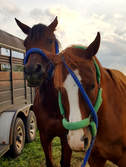
We arrived at camp and got the horses settled in without any hitches. When setting up our crew area we got our first hint of what was to come. After asking riders how their rides went we had answers ranging from, “so beautiful… but super technical” to, “Ohmygod… HILLS!!” The head vet, Dr. King, also stressed the technicality and difficulty of the trails during ride talk, reminding riders to be aware of the additional energy that inclines and declines demand of the horses, in relation to flat ground. After considering all the feedback, we amended our ride strategy to account for the hilly terrain; something we had extremely limited experience with!
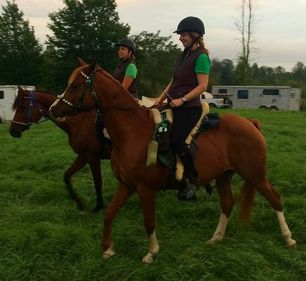
On a cool and humid Sunday morning we lined up with the other 50 milers (12 in total) to start the ride. One thing I will always be deeply grateful for is how calmly our horses approach the start of a ride. Because we, and they, aren’t very competitive it’s always a low-stress (but exciting!) start, watching the faster riders bound away down the trail while we settle into our happiest pace.
We headed off to the first 20-mile loop with fellow OCTRA rider Jess, who we had the pleasure of getting to know at the Summer Fling (the OCTRA ride we host in the summer). Starlet and Sasha were faced with tall, rocky hills, which they unexpectedly navigated extremely well. I guess I need to have more confidence in their abilities! There were a couple long stretches of flat ground, which the three horses ate up, and we were surprised to find the front-runners at the mandatory 10-minute hold halfway through the loop, just ready to head back out on trail. The 10-minute hold was at a lake, which would have been beautiful if it hadn’t started to absolutely pour rain! We electrolyted the horses and gave them some carrots (thanks, awesome volunteers!) and headed out to finish the first loop.
We headed off to the first 20-mile loop with fellow OCTRA rider Jess, who we had the pleasure of getting to know at the Summer Fling (the OCTRA ride we host in the summer). Starlet and Sasha were faced with tall, rocky hills, which they unexpectedly navigated extremely well. I guess I need to have more confidence in their abilities! There were a couple long stretches of flat ground, which the three horses ate up, and we were surprised to find the front-runners at the mandatory 10-minute hold halfway through the loop, just ready to head back out on trail. The 10-minute hold was at a lake, which would have been beautiful if it hadn’t started to absolutely pour rain! We electrolyted the horses and gave them some carrots (thanks, awesome volunteers!) and headed out to finish the first loop.
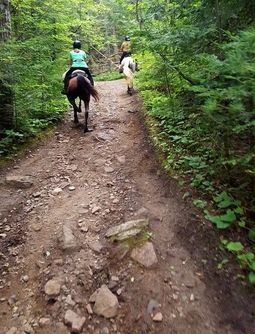
The rain continued once we were back on trail, with the horses bowing their heads to try to escape the pelting drops. The rain also made the rocks and grass on the hills verrrry slippery, so we were extremely careful navigating to avoid a slip and a tweaked muscle. We got to the first hold, untacked and cooled for about a minute (based on guesswork, since the heart rate wand wasn’t working), and went over to the vets. The horses passed with flying colours, but unfortunately we lost our riding companion Jess due to a bruised hoof.
At the vet check we bundled the horses up against the cold rain and gave them their feed – soaked alfalfa/timothy cubes (just like at home) and Trimax, with electrolytes. This is where a couple of lessons were reinforced, although we wouldn’t know the full ramifications until later: DO give your crew more guidance about how soupy to make the soaked cubes (how much water to put to how many cubes) and DON’T try anything new at a ride!
At the vet check we bundled the horses up against the cold rain and gave them their feed – soaked alfalfa/timothy cubes (just like at home) and Trimax, with electrolytes. This is where a couple of lessons were reinforced, although we wouldn’t know the full ramifications until later: DO give your crew more guidance about how soupy to make the soaked cubes (how much water to put to how many cubes) and DON’T try anything new at a ride!
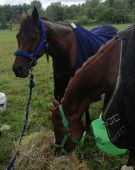
The feed was overly soupy, so the horses barely touched it – on top of that, to try to encourage them to eat the feed, some dummy (me) dumped a whole bunch of date syrup into the mix, under the hunger-impaired thinking that “horses like sugar, right?” ROOKIE MISTAKE! So we headed back onto the second loop with the horses having eaten significantly less than I would have liked. They ate dry hay and got electrolytes in syringes, but definitely did not get enough nutrients. At this first vet hold we also re-amended our ride strategy to the old standby: "to finish is to win!"
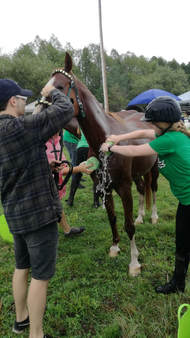
The second loop was 15 miles of constant, large rolling hills, with some long, steeper sections for variation. The scenery and trails were beautiful, just like the first loop, but the second loop definitely felt longer. The rain had stopped and was replaced by sun, heat, and high humidity. The horses were game and felt good, but definitely had less pep than on the first loop. Our second loop was almost as long as our first loop – 15 miles in 3 hours, as opposed to 20 miles in 3 hours – and as we came into the second hold we were DEFINITELY feeling it! Muscles that had never hurt during previous long rides were feeling the strain, and we were feeling pretty darn shell-shocked. It’s one thing to know, academically, that hills take a lot more out of you than flat land; it’s another thing to experience it and learn it on a profound level. Neither of us, and neither horse, had ever experienced any sort of terrain even close to the elevation changes at Calabogie (which to some people are probably laughable, but to us – who have literally not a single hill in our forest – were boggling), and the energy expenditure were becoming both physically and mentally draining.
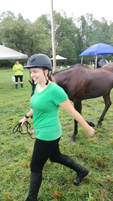
The horses vetted through with good hydration parameters and gait, but both horses had low gut sounds. This is where I really kicked myself for making such a dumb mistake with their feed at the last hold. Neither have ever had low gut sounds before at any ride, at any distance! They just simply did not have enough fuel in them. They ate and drank well at the hold – less-soupy soaked hay cubes, dry hay, and several apples – although of course, I would have preferred that they ate even more. We gave them an extra five minutes at the hold to see if they’d eat a bit more, then mounted up and headed out on the last loop.
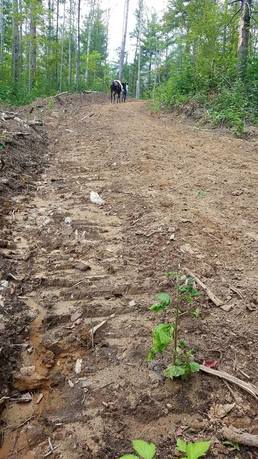
The last loop had long, steep inclines. We knew from the ride talk that there were sections of flat trail within the loop, but we hadn’t encountered them yet. Both horses and riders were flagging, so when we came to the bottom of another long hill we stopped. We looked at each other – two very determined ladies and two wonderfully willing horses – and had a quick pow-wow. Neither rider wanted to “give up”… but then again, what were we trying to prove, exactly? We weren’t trying to qualify for anything, or going for points, or trying to make a name for ourselves. We had set out to challenge ourselves and have fun with our amazing horses, and that we very surely did! Pushing the horses further would only increase their risk of injury and turn an exhausting but gratifying challenge into a sour slog.
So we turned back to camp, and by the time we returned we had completed 40 miles of pretty darn difficult terrain. We took a Rider Option and the horses vetted through with no problem and very low heart rates (48 bpm for Starlet, and 52 bpm for Sasha), and happily stuffed their faces into bowls of wet hay cubes. We got proud hugs from our crew – listen, 40 miles of hills is nothing to scoff at! – and sincerely thanked our amazing horses for their surprising skill and dexterity on challenging trails.
So we turned back to camp, and by the time we returned we had completed 40 miles of pretty darn difficult terrain. We took a Rider Option and the horses vetted through with no problem and very low heart rates (48 bpm for Starlet, and 52 bpm for Sasha), and happily stuffed their faces into bowls of wet hay cubes. We got proud hugs from our crew – listen, 40 miles of hills is nothing to scoff at! – and sincerely thanked our amazing horses for their surprising skill and dexterity on challenging trails.
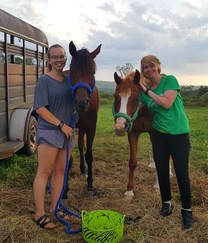
Could we have completed the course? Yes, and in the time allowed. However, it wouldn’t have left a good taste in our mouths. Our horses were tired and probably wouldn’t have enjoyed it; plus, the chance of injury on the hills increases exponentially with fatigue. And we riders were both physically and mentally tired, using different muscles riding up and down hills and watching the trail carefully to safely guide the horses. So, we eventually made peace with our decision to end on a tired-but-happy-and-proud note and tucked into a couple of beers with other riders and crew!
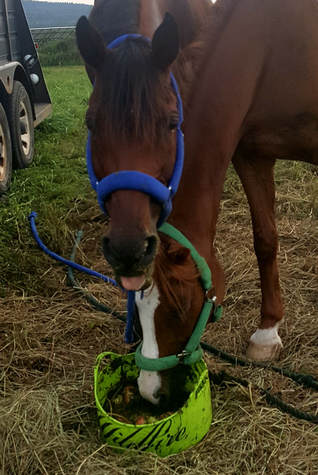
Lessons learned
- If you know there are idiosyncrasies about your feed or how your horses like their feed, don't expect your crew to magically understand vague instructions about how to prepare it! The horses weren't very interested in their overly soupy hay cubes the first hold, because I hadn't explained the ratio of water to cubes, or that the cubes need to be ripped into small pieces for better soaking, etc. Totally my fault, not that of our super amazing crew.
- For goodness sake, don't try anything new at a ride! This is the golden rule of Endurance riding, one I follow extremely carefully, and yet I fell into the trap anyway. If your horses haven't tasted date syrup at home, don't bust it out at a ride, and certainly don't just wing it in terms of quantity and delivery method! The horses would have had a lot more in the tank if I hadn't made a hunger-impaired decision. Which leads me to...
- Bring snacks on the trail, particularly during a 20 mile loop. I've learned this the hard way before, but apparently not enough, as I came into the hold starving and fatigued after a small breakfast at dawn. Not only did that make the ride physically harder than it needed to be, but also it also led to irritability focused at my crew (I'm sorry, you awesome, wonderful people!) and poor decision-making. Bring those darn granola bars!!
- The Wildfire horses really ARE much fitter and more skilled than I think. This is the first year where I've had the mentality of, "why not see what we really CAN do?" as opposed to a much more conservative and cautious ride strategy. Starlet and Sasha absolutely shocked me, being able to complete 40 miles of rocks and hills that they'd never experienced before, and at a pretty decent pace, and I think it gave me more confidence in their welfare even if we push them a bit.
- If you know there are idiosyncrasies about your feed or how your horses like their feed, don't expect your crew to magically understand vague instructions about how to prepare it! The horses weren't very interested in their overly soupy hay cubes the first hold, because I hadn't explained the ratio of water to cubes, or that the cubes need to be ripped into small pieces for better soaking, etc. Totally my fault, not that of our super amazing crew.
- For goodness sake, don't try anything new at a ride! This is the golden rule of Endurance riding, one I follow extremely carefully, and yet I fell into the trap anyway. If your horses haven't tasted date syrup at home, don't bust it out at a ride, and certainly don't just wing it in terms of quantity and delivery method! The horses would have had a lot more in the tank if I hadn't made a hunger-impaired decision. Which leads me to...
- Bring snacks on the trail, particularly during a 20 mile loop. I've learned this the hard way before, but apparently not enough, as I came into the hold starving and fatigued after a small breakfast at dawn. Not only did that make the ride physically harder than it needed to be, but also it also led to irritability focused at my crew (I'm sorry, you awesome, wonderful people!) and poor decision-making. Bring those darn granola bars!!
- The Wildfire horses really ARE much fitter and more skilled than I think. This is the first year where I've had the mentality of, "why not see what we really CAN do?" as opposed to a much more conservative and cautious ride strategy. Starlet and Sasha absolutely shocked me, being able to complete 40 miles of rocks and hills that they'd never experienced before, and at a pretty decent pace, and I think it gave me more confidence in their welfare even if we push them a bit.
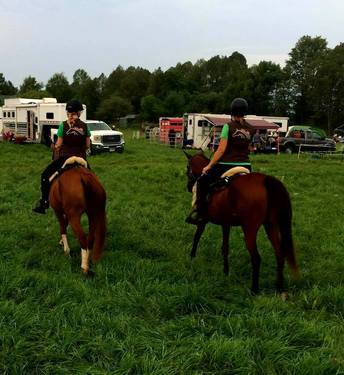
Next year
Will we attempt another 50 miles at Calabogie? Honestly, probably not. We don’t really train or condition for Endurance riding; it’s just a fantastic side benefit of riding through the forest where we live. Our forest is completely flat and we never go out-of-forest except for a few local Endurance rides. We don't really have the desire to trailer our horses elsewhere (i.e. to train on hills), so it wouldn’t be any more fair to ask the horses to complete the Calaboogie 50 next year. Next year we’ll probably do a lower distance and reap all the benefits of such beautiful trails without pushing our horses past what we’ve prepared them for. And you know what that means… more time for wine!!
Will we attempt another 50 miles at Calabogie? Honestly, probably not. We don’t really train or condition for Endurance riding; it’s just a fantastic side benefit of riding through the forest where we live. Our forest is completely flat and we never go out-of-forest except for a few local Endurance rides. We don't really have the desire to trailer our horses elsewhere (i.e. to train on hills), so it wouldn’t be any more fair to ask the horses to complete the Calaboogie 50 next year. Next year we’ll probably do a lower distance and reap all the benefits of such beautiful trails without pushing our horses past what we’ve prepared them for. And you know what that means… more time for wine!!
